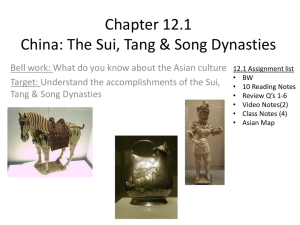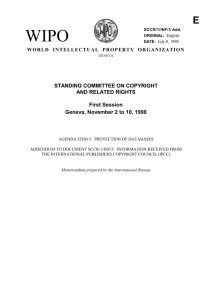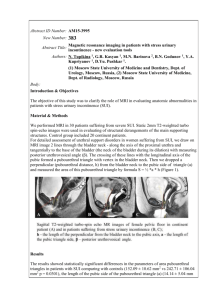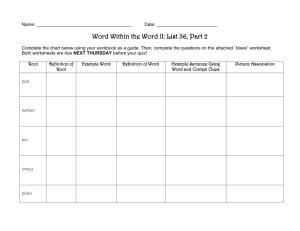Análisis de Opciones Sui Generis para la Protección del
advertisement
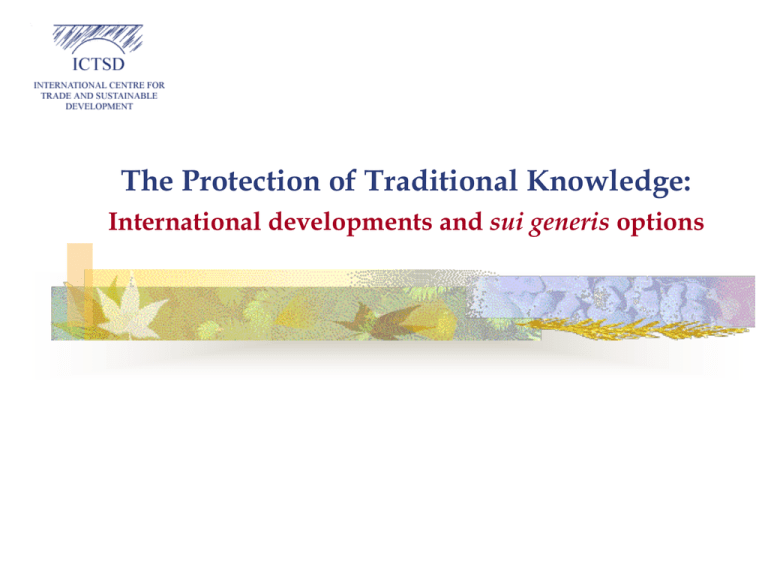
The Protection of Traditional Knowledge: International developments and sui generis options Road Map of the presentation Introduction What is TK Why TK is so important in the developing countries agenda? Main features of TK Main developments in the international arena CBD FAO WTO WIPO Some alternatives for a sui generis protection Some advantages and disadvantages of sui generis systems Some elements of potential sui generis systems identified in international debate Conclusions Introduction Broad definition of TK?: knowledge, information innovations, practices,, adaptations, expressions of indigenous and other local communities Why TK became part of the IP developing countries agenda Main features of TK It is knowledge: “information and skills acquired through experience and education”; It is traditional: created by continuous evolution and increasing additions (not old); Orientated towards practical solutions and survival and Generated in close relationship with the habitat; Hold by collective and individuals active persons; Private vs public right? – Public vs private domain? The issue of the public domain (secrecy and useful knowledge commercial novelty) In many cases there is a lack of material incorporation and oral transmission is used as a preservation rule; Not subject to scientific method; Holistic nature: combination of religious, cultural, political and commercial values; Regulated by customary law; Excluded: (religious –moral) Main developments in the international arena CBD Art 8j) and 10 c) Ad Hoc Open Ended Intersessional Working Group for the Implementation of Article 8(j) Approval of Bonn Guidelines Advice on application and development of legal and other appropriate forms of protection for TK; Recommend which of the work-plan objectives and activities should be referred to other international bodies or processes and identify opportunities for collaboration and coordination. Development of PIC and BS obligations including access to GR and associated TK Obligations of providers ( to facilitate access) and of demandeurs (respect of PIC and MATs) Results from the WSSD Call for increased participation of TK holders Encourage technical and financial support to implement national sui generis systems and traditional systems to protect TK FAO The new international treaty on Plant Genetic Resources: Article 9 on Farmers’ rights: to be developed at the national level The Parties have the responsibility for realizing Farmers’ Rights, as they relate to plant genetic resources for food and agriculture, rests with national governments. Parties should, as appropriate, and subject to its national legislation, take measures to protect and promote Farmers’ Rights, including: (a) protection of traditional knowledge; (b) the right to equitably participate in sharing benefits arising from the utilization of plant genetic; and (c) the right to participate in making decisions, at the national level. Nothing in this Article shall be interpreted to limit any rights that farmers have to save, use, exchange and sell farm-saved seed/propagating material, subject to national law and as appropriate. WTO Review of article 27.3b) Outstanding implementation issues (Tirett 88 and 95) Paragraphs 19 and 32 of the Doha Ministerial Declaration Protection of TK and folklore CTE agenda and relevant articles of the TRIPs Agreement Proposals by various developing countries and the African Group WIPO The IGC Discussions on defensive and positive options for protecting TK Some results: Updating the PCT minimum periodical list for PA determination Revise the PCT classification of Patents as to include patens based on TK An open a door for civil society actors in WIPO The Substantive patent law treaty (SPLT) and Patent Law Treaty Negotiations on a treaty that would regulate internationally substantive patent law Proposals by some developing countries; Brazil and Switzerland Some positive sui generis alternatives What is a sui generis system? System of its own kind Why do people tend to like this option? Very subjective content General classification of approaches on sui generis TK laws: The holistic protection approach Proposals derived form the ABS regimes Proposals derived form the IPRs system Sectorial options Eclectic options Approach Content Examples Holistic Human rights Customary law Land rights Self determination Options derived from the CBD regimes PIC Benefit sharing Conservation measures Bilateral contracts or annexes Options derived form IP Structural thesis: patent/copyrigths “Sui generis” database Some modification of existing IPRs Sectorial options Tripartite systems: Agriculture, health, folklore Eclectic options Blending of some CBD and IP principles: exclusive rights, registers, public/private domain Law of indigenous peoples rights in Philippines Cases of customary law protocols Biodiversity Law of Costa Rica Andean decision 391 OUA model Law (also some development of farmers’ rights -FAO) No law has included the first two ideas The Andean PI decision 486 The copyright law of Tunisia Plant variety law of Thailand/India TK law of Panama (main focus folklore) China patent law on traditional medicine Medida provisoria de Brazil Peruvian Law on indigenous knowledge (public domain) Advantages and disavantages of sui generis systems Advantages Flexibility in: Definitions Objectives, Subject matter Titleholders, etc. Might allow authomatic recognition of titleholders without formalities Can mix different types of systems: CBD, FAO, IPRs, customary law, etc. Allows enforcement by varios actors: Indigenous groups and CSOs Allows national or regional taylor-made solutions Disadvantages There are not a minimun internationally agreed principles (not even CBD ones) There is not a unique sui generis system There is not an international recognition There is not much experience on its practical application Enforcement mechanisms have not been developed There might be potential conflicts with multilateral IPRs agreements (TRIPS, PLT and future SPLT Some possible elements of positive sui generis systems identified by various actors Any system must recognize rights not create them TK is not in necessarily in the public domain Objectives: protection (defensive and positive), conservation, promotion, local development) Subject matter: definition vs specific criteria Scope: comprehensive vs sectorial Titleholders Depends on customary law: collective (total vs partial), individual Need for automatic recognition Prior informed consent Participatory process/transparency/inclusive Authorization rights Negative right (rigth to say no or/and withdraw from a contract) Benefit sharing Compensation vs patrimonial rights Need for defensive measures (disclosure –certificate of origin) Other possible rights: exclusive rights? Time of protection: permanent or long periods (i.e. 50 years) Existence of registers with different effects and purposes (erga ommnes vs among parties) Enforcement: ex officio vs private actions wide active legitimacy Some conclusions TK has a very particular nature that need to be addressed when designing protection systems Clear definition of objectives is fundamental for undertaking any further legal drafting exercises Participation of titleholders is important for the success of any national-regional-international processes National-regional experiences need to be encouraged and supported At the international level it is difficult to find a holistic-comprehensive unless joint process are initiated Policy spaces in international agreements for developing sui generis systems to protect TK should be enhanced and maintained There is an increase number of national-regional TK laws and experience will increase with the time Some elements are starting to be identified as possible minimum principles to protect TK



